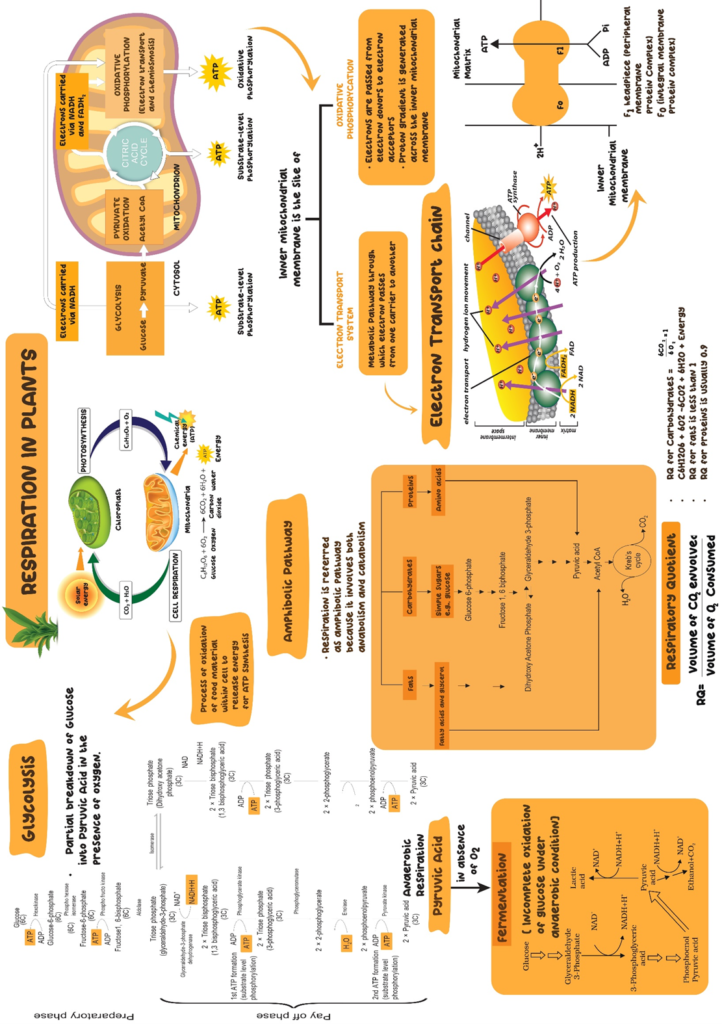

Respiration
Respiration is an energy releasing, enzymatically controlled catabolic process which involves a step-wise oxidative breakdown of food substance inside living cells.

Aerobic Respiration: Aerobic Respiration is an enzymatically controlled release of energy in a stepwise catabolic process of complete oxidation of organic food into carbon dioxide and water with oxygen acting as terminal oxidant.
Anaerobic Respiration: Anaerobic respiration is the type of respiration through which cells can break down sugars to generate energy in the absence of oxygen. This is in contrast to the highly efficient process of aerobic respiration, which relies on oxygen to produce energy.
Aerobic Respiration
- Glycolysis
- Kreb’s Cycle
- Terminal Oxidation
Glycolysis
- The scheme of glycolysis is given by Gustav Embden, Otto Meyerhof, and J. Parnas. It is also called as EMP pathway.
- Glycolysis is the partial oxidation of glucose or similar hexose sugar into two molecules of pyruvic acid through a series of enzyme mediated reaction releasing some ATP and NADH2. It occurs in cytoplasm.
- In plants glucose is derived from sucrose or from storage carbohydrates. Sucrose is converted into glucose and fructose by enzyme invertase.
- Glycolysis starts with phosphorylation of glucose in presence of enzyme hexokinase to form Glucose-6-phosphate. One molecules of ATP is used in this process.
- In next steps Glucose-6-phosphate is converted into fructose-6-phosphate, catalyzed by enzyme phosphohexose isomerase.
- Fructose-6-phosphate uses another molecule of ATP to form Fructose-1-6 biphosphate in presence of enzyme phosphofructokinase.

Tricarboxylic Acid Cycle/ Kreb’s Cycle
- The Acetyl CoA enters a cyclic pathway called TCA cycle or Kreb’s cycle.
- TCA cycle was discovered by Hans Krebs in 1940. This cycle is called TCA cycle because initial product is citric acid.
- Acetyl CoA combine with OAA (Oxaloacetic acid) and water to yield citric acid in presence of enzyme citrate synthase to release CoA.
- Citrate is then isomerized to isocitrate. It is followed by two successive steps of decarboxylation, leading to the formation of α-ketoglutaric acid and then succinyl-CoA.
- In the remaining steps, succinyl-CoA is oxidized to OAA allowing the cycle to continue.
- There are three points in the cycle where NAD + is reduced to NADH2 and one point where FAD + is reduced to FADH2.
- A molecule of glucose produces two molecules of NADH2, 2ATP and two pyruvate while undergoing glycolysis. The two molecules of pyruvate are completely degraded in Krebs cycle to form two molecules of ATP, 8NADH2 and 2FADH2.

Terminal Oxidation
Terminal Oxidation is the name of oxidation found in aerobic respiration that occurs towards end of catabolic process and involves the passage of both electrons and protons of reduced coenzyme to oxygen to produce water.
Electron Transport Chain
- The metabolic pathway through which the electron passes from one carrier to another inside the inner mitochondrial membrane is called ETC or mitochondrial respiratory chain.
- Electrons from NADH produced during citric acid cycle are oxidized by NADH dehydrogenase and electrons are transferred to ubiquinone located within the inner membrane. Ubiquinone also receives electrons from FADH2 which is transferred to cytochrome c via cytochrome bc1 complex.
- When the electrons pass from one carrier to another via electron transport chain, they produce ATP from ADP and inorganic phosphate. The number of ATP molecules synthesized depends upon electron donor.
- Oxidation of one molecule of NADH gives rise to 3 molecules of ATP, while oxidation of one molecule of FAD2 produce two molecules of ATP.

Oxidative phosphorylation
It occurs in respiration process. Energy of oxidation-reduction is used for production of proton gradient required for phosphorylation.
Photophosphorylation
It occurs in photosynthesis. Light energy is utilized for production of proton gradient for phosphorylation.
Fermentation
- It accounts for incomplete oxidation of glucose.
- In fermentation, there is net gain of only two molecules of ATP.
- NADH is oxidized to NAD+ very slowly.
Aerobic Respiration
- It accounts for complete oxidation of glucose.
- In aerobic respiration, there is more net gain of ATP.
- NADH is oxidized to NAD+ very fast.
Amphibolic Pathway
- Glucose is the favored substrate for respiration. All carbohydrates are usually converted into glucose before used for respiration.
- Fats needs to be broken down into glycerol and fatty acid, which is further broken converted into Acetyl CoA and enter the respiratory pathway.
- Proteins are broken into amino acids and further enter Krebs cycle.
- Breaking down process within living organism is called catabolism and synthesis process is called anabolism process. So, respiration is an Amphibolic pathway.
